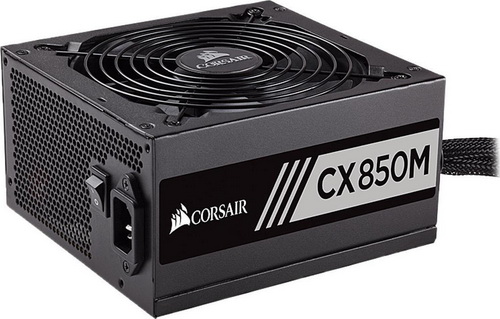INTRODUCTION

The benefits of having a good power supply unit in your system have been mentioned by us more times than i can possibly count but even so it seems that the majority out there still places this specific hardware component last after pretty much everything else. The most recent example i have of this was almost a week ago when my cousin started building a new rig and decided to pair an Aorus GeForce RTX 2080 Super with a budget 550W PSU from a virtually unknown manufacturer (at least until he could afford something better - it's a good thing i was able to give him something much better to avoid any mishaps). This of course is not the only time I’ve seen something like that and it almost always falls upon me to change the minds of friends and other relatives who thought about doing the same. CORSAIR has a rather long history with power supply units and since some of you have asked today, I’ll be testing one of their not so "popular" models, the CX850M 2017 Edition (V2).
Founded in 1994, CORSAIR has grown from pioneering the high-performance DRAM market into one of the world’s leading providers of high-performance gaming and streaming products. CORSAIR offers a complete range of products to equip gamers, enthusiasts, and esports athletes, including mechanical keyboards, precision gaming mice, wireless headsets, premium PC components, and the CORSAIR ONE fully-integrated gaming PC. With a company-wide commitment to quality, innovative design, advanced features and high-performance, CORSAIR products have won thousands of media and industry awards, earning their place in gamers’ hands and PCs following years of development and engineering by a team dedicated to building great products that they themselves would want to use. In 2018 CORSAIR acquired Elgato Gaming, a manufacturer of streaming products. In 2019 CORSAIR acquired Origin Computers, a manufacturer of custom high-performance gaming PCs and laptops, and SCUF Gaming, an innovator and creator of high-performance gaming controllers.
The CX850M 2017 Edition (V2) is an 850W unit (also available in 450/550/650/750W) that has been around for quite a few years now (2017 edition) and is the successor to the first CX850M released back in early 2015. This is an 80 Plus Bronze certified (up to 85% electrical efficiency) unit which can deliver up to 850W of continuous power (1KW peak) and features a semi-modular design, powerful 70.8A single +12V rail which can deliver the units entire power output, Japanese capacitors, ATX v2.4 support and several electrical protections including OVP (over-voltage), UVP (under-voltage), SCP (short-circuit), OPP (over-power) and OTP (over-temperature). Yes, this may not be the newest kid on the block but since you asked (and also since there are almost no reviews of it around) let's take a closer look.
SPECIFICATIONS AND FEATURES

PACKAGING AND CONTENTS
The main product features can be seen at the front of the box along with the company logo, output and of course a large product picture.
CORSAIR has printed the main product pictures on the left side in 3 languages.

 All available power connectors are listed on the base of the box and at the top we find a few words about the 80 Plus Bronze certification in 7 languages.
All available power connectors are listed on the base of the box and at the top we find a few words about the 80 Plus Bronze certification in 7 languages.
Three product pictures are located at the rear alongside two charts, the electrical table and a few words about the product again in 7 languages.
As usual the PSU is placed between two thick pieces of cardboard (and wrapped inside a plastic bag) while the rest of the bundle is placed next to it.
Along with the CX850M and its power cord and modular cables you're also getting 10 cable ties, 4 mounting screws, important safety information paper and the user manual.
THE CX850M V2 EXTERIOR
CORSAIR gave the CX850M 2017 Edition a round braided power cable for the motherboard (24pin) and flat power cables for both the graphics cards and SATA devices.
The CX850M V2 has the motherboard cable hardwired into its chassis which measures 150mm in width, 160mm in length and 86mm in height.
A 120mm fan is placed at the top beneath a regular grill with the company logo.
Both the company and model names are printed on both sides of the enclosure.
Turning the PSU over we find a large sticker containing the electrical specifications table.
All 6 modular connectors are tagged and different in size/shape.
At the rear we find the typical honeycomb perforation, power on/off button and the power port.
THE CX850M V2 INTERIOR
The 120mm fan used is manufactured by Yate Loon Electronics and can reach speeds of up to 2800RPM to produce airflow levels of up to 140CFM with up to 48.5dBA of noise (these are the official manufacturer specs, CORSAIR probably used a lower RPM profile).
Judging by the design of the platform this unit is probably manufactured by CWY (Channel Well Technologies).
The primary capacitor is manufactured by the Japanese Rubycon and is certified for up to 105 degrees Celsius.
Secondary capacitors are manufactured by United Chemi-Con and MF electronics (i think, first time I’ve seen these) and are also certified for up to 105 degrees Celsius.
TEST BED


TESTING METHODOLOGY
Using a dedicated measurement instrument such as a Chroma or a SunMoon to test power supply units is without doubt the most ideal and accurate way (not to mention the fastest) to do that currently. However, it's certainly not the only way there is and so pretty much anyone can test a power supply unit just by using a test rig. Certainly, limitations do apply and so you can't really push a 1000W power supply to its limits if your system only uses 500W at peak loads and that's why over the years we saved certain hardware components for the purpose of building a dedicated PSU test rig. True it may not be as accurate as the above mentioned solutions but it comes really close and is in fact much closer to real world usage. So as always, we ran several games with maximum graphic options enabled at a resolution of 2560x1600 in order to stress every hardware component and increase the overall power demands of the system. The Passmark BurnIn Test was also used to overstress the components in an effort to provide the most accurate results possible. As a final test we also used the latest OCCT 4.4 software and its dedicated PSU testing suite since it can really bring a power supply to its knees after inside a few minutes.
Rail stability was checked/measured with the CPUID Hardware monitor and a Metex multimeter which also recorded the system load in idle and in load. As always try to remember that the power consumption numbers listed in the graph are the highest (Peak) ones recorded during the entire duration of the tests and not the average ones. Noise levels coming from the fan were recorded using the high precision HD600 ExTech Sound dBA Meter from the rear of the unit and at a range of no more than 5-10cm. Readings under load are recorded the exact moment we manually switch the fans of all graphics cards from full speed to almost zero, that way the fan of the power supply does not have enough time to slow its RPM and so by doing this we get very accurate noise level readings. Needless to say in order to get 100% accurate readings you need to have a noise isolated room for that exact purpose, something which is quite impossible unless you are working inside a real lab (some people use very small noise insulated boxes but due to their size both heat and noise exceed normal levels and so the results can't really be considered to be 100% accurate, nor realistic for that matter). Also do take into account that since all noise measurements take place from just 5-10cm away the final noise levels to reach your ears will be considerably less.
* After well over 10 years of testing PSUs the Intel Core i7-920 CPU of this rig failed and so we replaced it with a Xeon X5660 (we also swapped the GA-X58A-UD7 for the G1. Assassin).
TEST RESULTS



CONCLUSION

The CX850M 2017 Edition (V2) may already count 3+ years in the market but it’s still a quality PSU that offers very good rail performance (even tighter compared to many newer PSU models by numerous manufacturers), 850W output (1KW peak), 80 Plus Bronze electrical efficiency (yes here things could be better), an array of electrical protections, mostly Japanese made capacitors and a 5-year limited warranty. The 120mm fan by Yate Loon did become quite noisy during our tests and especially when the test rig reached its peak consumption but that specific fan model is known to do exactly that.
Now the really good news is that after so long in the market the remaining stock of the CX850M 2017 Edition (V2) can be found for as low as USD44.48 inside the USA (Newegg.com) and for around 70Euros inside the EU. So, if 850W is more than enough to power your system and the 80 Plus Bronze certification along with the semi-modular design are not deal breakers for you then looking for one of the remaining CX850M 2017 Edition power supply units should be your priority.
PROS
- Build Quality
- Very Good Rail Stability
- 80 Plus Bronze Certified
- Electrical Protections
- Peak Output (1KW)
- 5 Year Warranty
- Price (For Some)
CONS
- Noisy At Over 70% Capacity
- Current Availability
- 2017 Model

 O-Sense
O-Sense
























.png)

